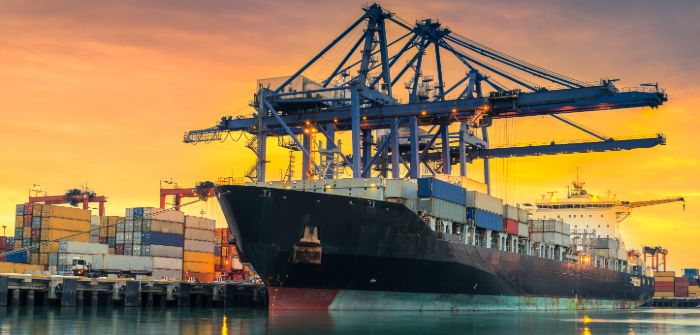Electric and hybrid propulsion is just for ferries, right? Wrong. As Philip Holt of MAN Energy Solutions tells us, despite evidence to the contrary, there’s a place for batteries on the big ships.
“We have a rule that we evaluate battery technology in a holistic way on a case-by-case basis,” says Philip Holt, naval architect at MAN Energy Solutions’ Marine Project Engineering department in Copenhagen. That’s just as well because when put under the MAN ES critical microscope, the returns for energy storage installations (ESS) on board ocean-going cargo vessels look frankly disappointing. Firstly, Holt explains, replacing the typical slow-speed, two-stroke main engines during transits “would usually mean an unfeasibly large battery”.
This might have been expected, but owners and developers should beware as even the sums for peak shaving applications may not add up in connection with two-strokes.
 Holt outlines a MAN ES study, which investigated using a battery to peak shave the torque cycles produced by varying propeller loads on a 6G70ME-C9.5 main engine. MAN ES’s holistic evaluation meant looking closely at all the variables – right down to specific fuel consumption, rotation speed and even inlet/outlet temperatures. The crux of the matter, says Holt, stands out from all the detail: although engine loads rise and fall between 65% and 85% of its total 15,570kW, “using a battery to peak shave creates power losses from the generator, motor, and so on”.
Holt outlines a MAN ES study, which investigated using a battery to peak shave the torque cycles produced by varying propeller loads on a 6G70ME-C9.5 main engine. MAN ES’s holistic evaluation meant looking closely at all the variables – right down to specific fuel consumption, rotation speed and even inlet/outlet temperatures. The crux of the matter, says Holt, stands out from all the detail: although engine loads rise and fall between 65% and 85% of its total 15,570kW, “using a battery to peak shave creates power losses from the generator, motor, and so on”.
So, while an ESS could save about 0.4% of the mean load, it’s far outweighed by its losses, which can be up to two-and-a-half times higher. “These large, two-stroke marine engines are hard to beat when it comes to efficiency,” says Holt, “even under heavy load variations.”
Think grid
Still, even if batteries hold little allure for the main propulsion, there may still be a place for them on board the big ships. “The picture is very different when you’re looking at electric power production by four-stroke gensets,” says Holt. “A number of familiar energy efficiency strategies can be applied to auxiliary engines.”
However, care is still necessary when evaluating the potential advantages. Holt mentions as a case study an 82,000 deadweight bulk carrier which typically has three 5L23/30 MAN auxiliaries to feed an onboard grid with a base hotel load of 280kW. “MAN ES has worked on two different scenarios,” he says. “The first is to use a battery to replace one of the engines in its entirety, so installing just two auxiliaries in total.” Combine these two with a 1,866kWh battery, modestly run between 0.15% and 0.35% of its nominal C-rate to extend its life, and the result would allow just one auxiliary engine to operate at 80% load without compromising redundancy during critical operations such as maneuvering.
“The other option is to retain the three existing auxiliaries, but add a comparatively small battery installation that covers the power for 15 minutes,” explains Holt. “This is just enough time to avoid blackouts and restart another engine, but not take on extended high-power operation such as continuous maneuvering.”
If the battery can be operated at three times its standard C-rate – not an excessive demand for an installation that won’t be used all that often – the energy can be provided by a 217kWh battery.
The expected return on investment (ROI) is very different: while the six-hour installation ROI for the above reference still takes 28 years even accounting for dropping one auxiliary engine, the smaller battery installation could pay back in six years (both given a US$500/kWh investment price and stable fuel costs).
Lifts get a lift
Despite this, the arguments for batteries can stack up. “Take a bulk carrier or tanker that has to rely on its own lifting or offloading gear,” comments Holt. “This could benefit from a peak shaving application as very
often these cargo ships are operating in areas with little or no mechanical handling support on the quay.
“Even though we’re only talking about fairly modestly sized cargo equipment, onboard cranes or pumps can still push the power demand almost vertically upward, from an average 600kW to over 800kW in just a few seconds, resulting in significant increases in fuel consumption. Plus, there may be an argument for sizing it for the spinning reserve as well.”
However, if up-front costs are putting off potential investment in an electrical energy storage system, there’s a more subtle application to consider. Bang-for-buck, dynamic load transition is possibly one of
the most interesting battery applications. “It’s really peak shaving-lite,” says Holt. “The idea isn’t to flatten the peaks entirely, but instead letting the auxiliaries take up – or drop – the load. Just more gently.”
As it can react fast, the battery is able to smooth the step changes to a couple of almost straight load transitions. However, it should be noted that the MAN ES example refers to a cycle that completes in around 200 seconds: since this infers it’s going to be hitting those peaks fairly frequently, the battery should be sized to cope with a moderate cycle rate.
There are a lot of advantages for doing this much: get it right and the result achieves more than lowering fuel consumption and maintenance, as it also helps to avoid increased particulate emissions as well as
the kind of knocking behavior exhibited by low-pressure gas engines under strain.
PTO wins
There’s one more element that MAN ES has considered under its holistic evaluation policy: while underway, a power take-off (PTO) from the main engines is also the most efficient method of charging the batteries. “This is particularly effective as two-stroke engines typically have a specific fuel oil consumption (SFOC) of around 160g/kWh,” says Holt, “and applying a normal-sized PTO to charge the batteries will only increase the SFOC by approximately 1%.
“Compare that to a four-stroke genset, which has an SFOC 185g/kWh at best. Even if these gensets are combined with a battery to allow them to run at their sweet spot all the time, the resulting power is still produced at a lower energy efficiency than sailing with a PTO.”
This underexplored possibility could prove very useful for ro-pax or ro-ro vessels, “Or any vessels that tend to have a number of shorter hops and port stays of a few hours each,” concludes Holt.
Using the harvested energy in this way not only has the potential to eliminate emissions while at berth, but also to reduce the overall energy consumption. Such benefits more than justify the placement of batteries on the big ships.
By Stevie Knight



